Solving Quarrying and Mining Tramp Metal Problems
By Paul Fears | 14 January 2025
Tramp metal exists in all mining and quarrying operations. The problematic contamination is difficult to avoid. The nature of mining and quarrying – extracting ore and aggregate using large heavy equipment – results in a wide variety of tramp metal contaminating the mined material. Such metal needs identifying and removing before potentially causing costly damage to processing equipment (e.g., crushers, screens, and conveyors). Additionally, for many mining operations there is a maximum metal contamination content in the mined ore specified by the end-customer (especially in coal supplied for power stations). This article assesses the optimum methods employed to solve quarrying and mining tramp metal problems.
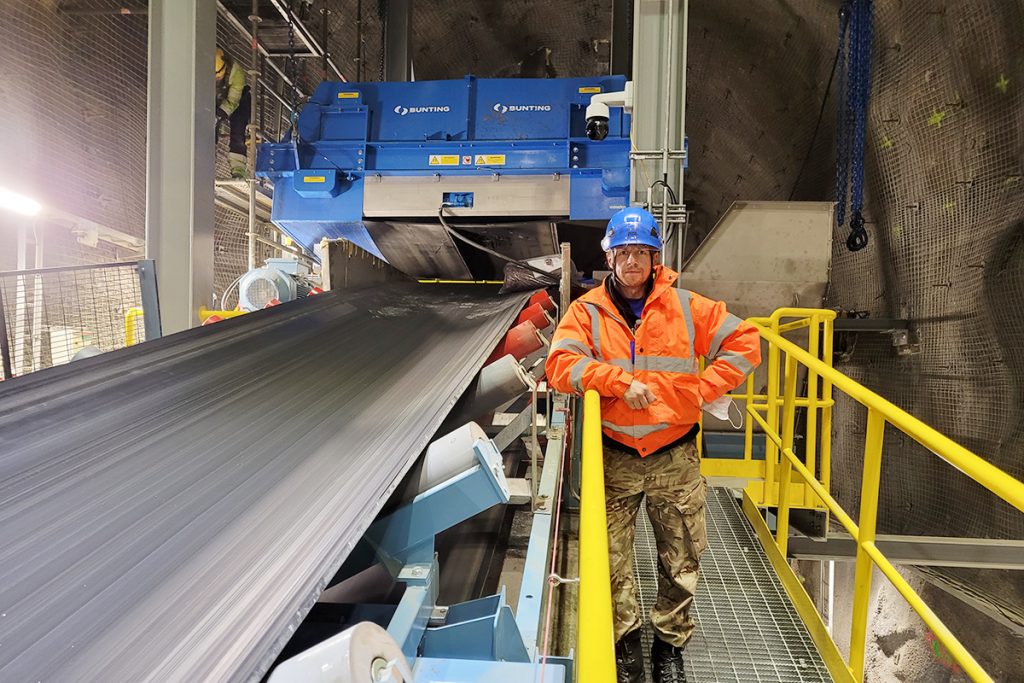
Origin of Quarrying and Mining Tramp Metal
Understanding the source and nature of the tramp metal is the first stage in the process of effective removal. The definition of ‘tramp metal’ is any item of rogue metal not naturally present in the mined ore or quarried aggregate. Such contamination includes digger teeth, pit props, blasting caps, nuts and bolts, and metal originating from the wear and tear of process plant.
Most mining operations involve a staged process of recovering the valuable ore, including size reduction (e.g., crushing and milling) to reduce the particle size and liberate the ore from the gangue (the commercially worthless material that surrounds, or is closely mixed with, a wanted mineral in an ore deposit), and segregation into different sized fractions (screening). Quarrying aggregates follows a very similar process. The processing equipment used at both these stages are most at risk of damage from tramp metal.
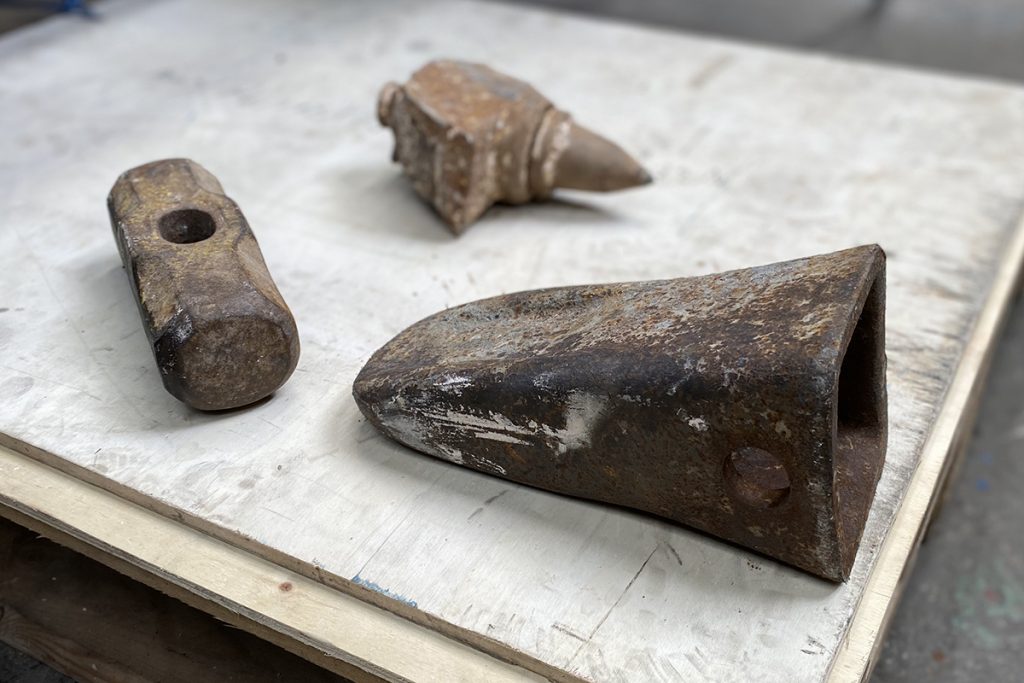
Mining and Quarrying Processing Equipment at Risk
Crushers
Mined ore and aggregate size reduction often involves several stages using different types of crushing technology. Jaw crushers and Gyratory crushers are mainly used as primary crushers and, subsequently, are exposed to damage from larger tramp metal. Cone crushers resemble gyratory crushers, but are popular in secondary, tertiary, and quaternary crushing stages and are very sensitive to smaller tramp metal contamination. Impact crushers are versatile crushing machines used at any stage of the crushing process.
Jaw crushers reduce the size of rock and other materials between a fixed and a moving jaw. The moving jaw is mounted on a pitman that has a reciprocating motion, and the fixed jaw stays put. When the material runs between the two jaws, the jaws compress larger boulders into smaller pieces. Tramp metal entering the jaws damages the surface liner of the jaw, potentially reducing the crushing efficiency and tight sizing of the crushed rock. Larger rogue metal causes severe damage, resulting in liner and pitman replacement.
Gyratory crushers feature an oscillating shaft with material reduced in a crushing cavity between an external fixed element (bowl liner) and an internal moving element (mantle) mounted on the oscillating shaft assembly. The fragmentation of the material results from the continuous compression that takes place between the liners around the chamber. An additional crushing effect occurs between the compressed particles, resulting in less wear of the liners. Tramp metal seriously damages the central mantle and, when large enough, blocks the output. This puts pressure on the whole system, causing catastrophic damage to the internal crushing mechanisms.
Cone crushers resemble gyratory crushers and are commonly used on rock of smaller particle sizes (either by nature or primary crushing). In a cone crusher, the material is crushed in a crushing cavity between an external fixed element (bowl liner) and an internal moving element (mantle) mounted on the oscillating shaft assembly. An eccentric shaft rotated by a gear and pinion produces the oscillating movement of the main shaft. The eccentricity causes the cone head to oscillate between open side setting and closed side setting discharge opening. The fragmentation of the material results from the continuous compression that takes place between the liners around the chamber. An additional crushing effect occurs between the compressed particles, resulting in less wear of the liners.
The operating nature of cone crushers makes them particularly sensitive to all sizes of tramp metal. As with the Gyratory Crusher, tramp metal damages the central mantle, the concave, and bowl liner, as well as causing blockages. Repair costs tend to be very high, with extensive rework and replacement parts.
There are two types of Impact Crusher: Horizontal shaft impact (HSI) and Vertical shaft impact (VSI). HSI crushers are used in primary, secondary or tertiary crushing stage reducing the feed material size by highly intensive impacts originating in the quick rotational movement of hammers or bars fixed to the rotor. The particles produced are then further fragmentated inside the crusher as they collide against crusher chamber and each other, producing a finer, better-shaped product.
In contrast, VSI crushers feature in the final stages of the crushing process, especially when the end product requires a precise cubical shape. VSI crusher can be considered a ‘stone pump’ that operates like a centrifugal pump. The material is fed through the centre of the rotor, where it is accelerated to high speed before being discharged through openings in the rotor periphery. The material is crushed as it hits of the outer body at high speed and due to rocks colliding against each other.
The presence of all sizes of tramp metal in the feed material results in serious and costly damage to the main rotor and impact plates. The repair costs are often significant, with the additional loss of production and associated revenue.
Screens
As with crushing technology, there is a wide range of screen designs used in the mining and quarrying industries to suit different applications including dewatering screens, grizzly screens, single and double deck linear screens, and trommel screens.
Grizzly and Trommel screens are commonly located between the primary feeder and crusher. On a Grizzly screen, mined rock feeds across parallel and inclined steel bars or rails. These screens feature heavy-duty manganese steel or high-impact alloy screens are for extreme wear resistance, but there is a risk of damage from large and especially long tramp metal. Similar long tramp metal also causes wear, damage and blockages in Trommel screens where mined rock feeds into large diameter rotating trommels. The holes in the trommel dictate the screening particle size, with one trommel commonly set to separate several different sized fractions. Tramp iron causes trommel blockages and also damages the holes, altering the sizing characteristics.
Smaller particle segregation, with single and double desk linear screens, occurs later in the process. The wide range of screen media includes wire and urethane and both are susceptible to damage from tramp metal. Metal wire screens can break, resulting in the post-screened rock being contaminated by newly introduced and smaller metal contamination. Urethane screens get punctured or cut by tramp metal, changing the screening efficiency. If unnoticed, screen damage results in a failure to meet tight product sizing targets.
Dewatering screens remove moisture from a material, especially in aggregate and mineral processing operations. Tramp metal hitting the linear motion, inclined screen damages the screen surface, once again seriously degrading the sizing efficiency.
Stopping Tramp Metal Damage
The nature of the rock, the process, and the tramp metal dictates the optimum metal contamination solution. The two technologies commonly used in mining and quarrying operations to prevent processing plant damage from tramp metal contamination are Magnetic Separators and Metal Detectors.
Magnetic Separators
Magnetic Separators separate magnetically-susceptible tramp metal (e.g., steel and iron), automatically removing the problematic contamination from the rock. Selection of the optimum magnetic separator design for any given application is determined by the process and material specifications.
Overband and Suspension Magnets
An Overband or Suspension Magnet is positioned over a conveyor, with tramp iron attracted up and out of the conveyed rock. The ‘Suspension’ design features a magnet block which requires the manual removal of separated metal from the magnet face and is suited for installations with very occasional metal contamination. The ‘Overband’ design includes a self-cleaning belt that automatically removes captured metal away and into a collection area and is the best option with higher levels of metal contamination.
The magnetic field of both the Suspension and Overband Magnets is produced using an enclosed casing of carefully arranged permanent magnets or an electromagnetic coil wound around a steel core.
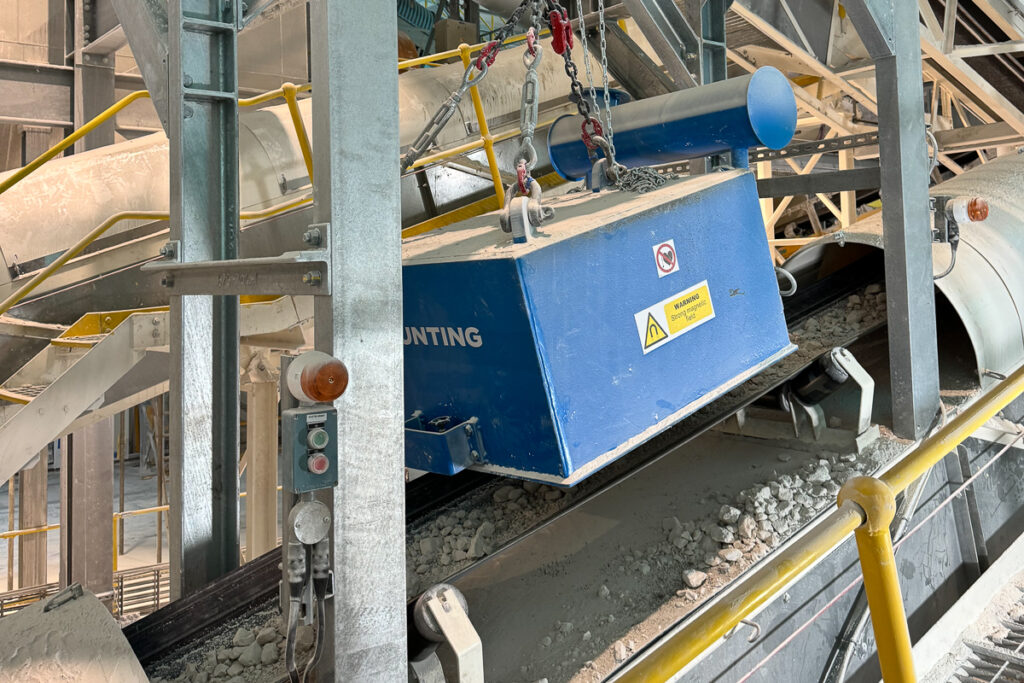
Permanent Overband and Suspension Magnets feature widely on mobile crushers and screens, especially for sites recycling demolition waste and quarries. Although some permanent Overband and Suspension Magnet designs operate at high suspension heights, the majority are suited for positioning at a maximum height of 300mm above the conveyor. Such permanent designs successfully separate larger longer tramp iron such as rebar.
However, many mining operations have wide conveyors transporting large volumes and deep burdens of ore. This raises the suspension height of the Overband or Suspension Magnet, as well as creating a far more difficult separation environment. Tramp metal often migrates to the bottom of the burden and the magnetic field intensity must be strong enough to not only attract, but also move the tramp metal through the mined ore. Such applications are better suited to Electro Overband or Suspension Magnets, which generate a far deeper and stronger magnetic field than the permanent design.
When projecting a deep and intense magnetic field, the electromagnetic coil generates a great deal of heat. As the coil heats up, so the magnetic performance decreases. Therefore, the design must incorporate efficient coil cooling systems using either oil or air. In oil cooled designs, the electromagnetic coil is immersed in a sealed oil bath inside a metal box. The ever-circulating oil transfers the heat from the coil to the outer walls of the metal box, where it is released and the oil cools. For enhanced magnetic performance of smaller coils, the oil is forced cooled by being passed through externally-mounted radiators and fans.
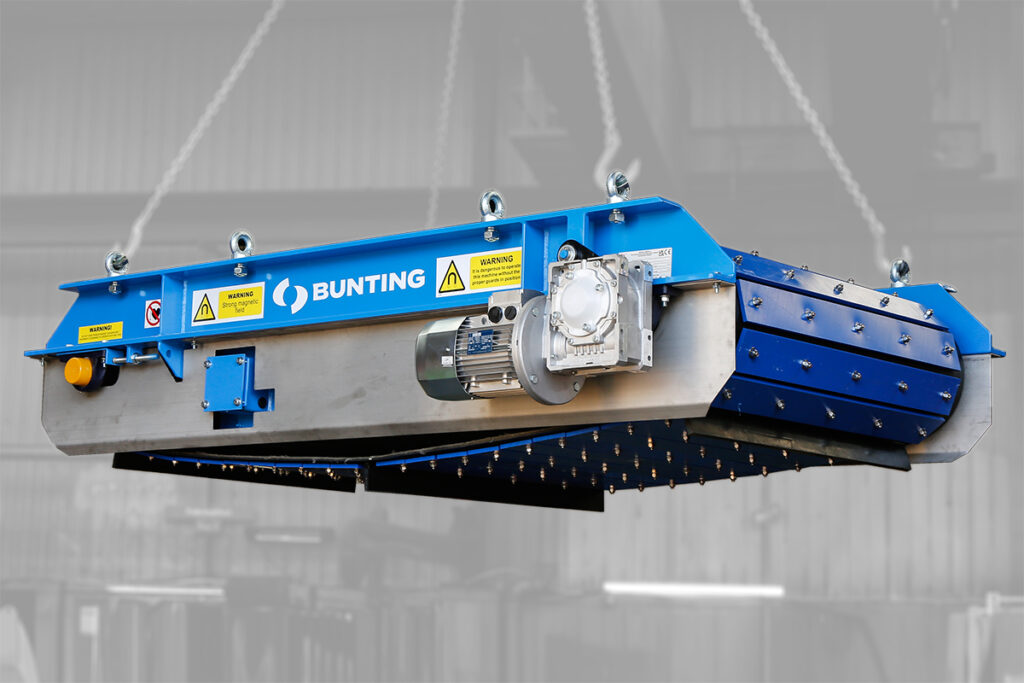
Air cooled designs incorporate various cooling mechanisms including fans blowing air onto the coil, and aluminium fans radiating out from the coil. Bunting’s air-cooled ElectroMax model is specifically designed as a compact but powerful electro overband or suspension magnet, ideally suited for installations where there is limited space.
The shape and strength of the magnetic field projected by the electromagnet enables enhanced separation of smaller tramp iron such as bolts and nuts.
For both permanent and electromagnetic designs, positioning the surface face of the magnet as close as possible to the conveyed material enables the most effective metal separation. However, surges in material can produce variable burden depths. When the suspension height of an Overband or Suspension Magnet is very close to the top of the burden, such surges can result in conveyed rock striking the magnet, causing damage to the magnet and self-cleaning belt mechanism. Surge protection systems prevent such damage and include sensors to automatically raise the magnetic separator, and bars to spread and reduce the burden depth.
In many mining and quarrying installations, the Overband or Suspension Magnet work in conjunction with a Metal Detector. The configuration is dictated by the installation, with Metal Detectors either placed prior to or after the magnetic separator. In some installations, a Metal Detector positioned just in front of an electromagnetic magnetic separator identifies tramp metal and then sends a signal to turn the magnet on. Such a configuration suits installations where there are very low levels of metal contamination and a need to conserve electric energy.
More commonly, the Metal Detector sits after the magnetic separator to locate non-magnetic tramp metal not separated by the magnet.
Case Study
A 13-tonne Electro Overband Magnet designed and built by Bunting operates in a gold mine in Northern Finland. Over a twelve-month operating period, the Overband Magnet will lift and separate damaging tramp metal from approximately 2.7 million tonnes of conveyed ore, protecting crushers, screens and other up-stream process plant.
Magnetic Head Pulleys
A permanent or electromagnetic Magnetic Head Pulley replaces the standard head pulley of a conveyor. In operation, any tramp iron present in the conveyed rock and reaching the end of the conveyor is attracted to the Magnetic Head Pulley and held onto the surface of the conveyor. As the returning conveyor leaves the under surface of the pulley, the separated tramp iron falls away under gravity into a designated collection area.
Larger and heavier tramp metal has a tendency to migrate to the bottom of the burden, making it more difficult to separate using a Suspension or Overband Magnet, but easier on a Magnetic Head Pulley. Long tramp metal is more difficult to separate using the pulley design as there is limited magnetic-field-to-metal contact as the long bar passes over, especially if aligned in the direction of flow.
The Magnetic Head Pulley suits existing installations where space is limited, restricting the possibility of installing Overband or Suspension Magnets over conveyors.
The Magnetic Head Pulley has one continuous magnetic field covering the whole circumference. The permanent magnet design is a solid structure with the whole pulley rotating as one and the magnet element integrally bound with the outer shell, rotating in unison. The electromagnetic version features a centralised stationary coil generating a deep and strong magnetic field and produces the strongest and deepest magnetic field and is better suited for high-volume mining applications.
As the magnetic separator replaces the head pulley, the outer shell of both the permanent and electromagnetic models are commonly coated in a rubber lagging to provide extra grip to the conveyor.
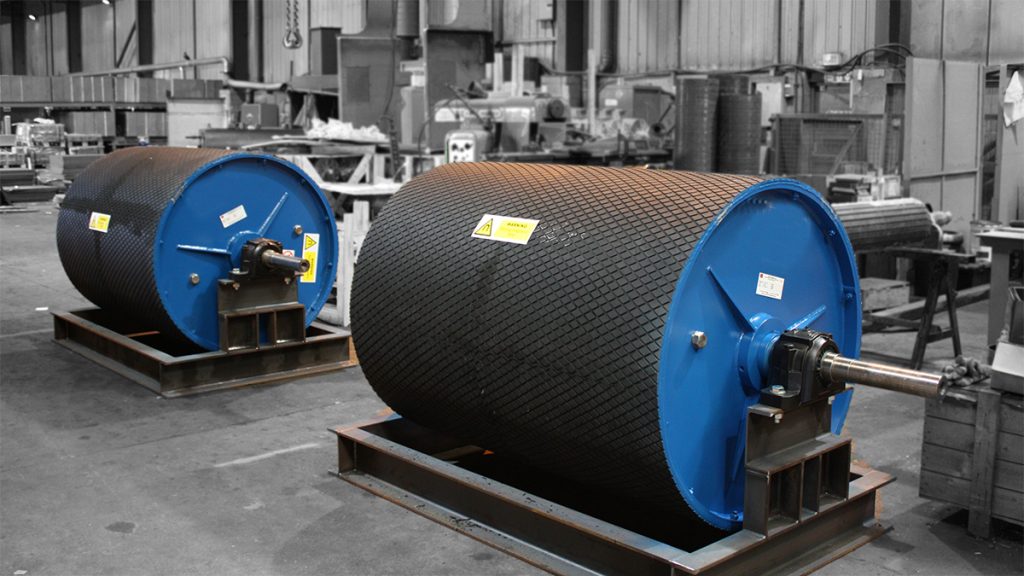
Case Study
Two permanent Magnetic Head Pulleys, both 1.2m in diameter, operate in an iron ore mine in Sweden, removing large tramp metal from iron ore prior to crushing and screening. In this iron ore application, the conveyors are 1.2 metres wide and travelling at 2 metres per second. The conveyor is carrying 650 tonnes per hour of iron ore with a bulk density of 2.4 tonnes per cubic metre. As the Pulley Magnets operate as the drive pulley, they are lagged with rubber to provide extra grip on the underside of the conveyor belt.
Drum Magnets
The Drum Magnet often provides the optimum separation of tramp iron, but is less frequently employed due to installation space restrictions. Drum Magnets have a centralised, stationary magnetic element (permanent or electromagnetic) around which rotates a non-magnetic shell. Ore feeds onto the top of the rotating shell, commonly via a vibratory feeder. Tramp metal and other magnetics attract to the magnetic element and are held on the rotating shell before discharging when leaving the magnetic field beneath the drum. Other non-magnetic material flows in a normal trajectory and the two flows are separated by a strategically placed splitter.
The Drum Magnet achieves the highest possible level of tramp metal separation, with magnetic particles flowing close to the magnetic field. Larger diameter Drum Magnets, rotating at high speeds, handle larger volumes of rock. The close proximity of the magnetic field to the rock means that stronger Drum Magnets with neodymium magnets are capable of separating weakly magnetic rocks, the target in many mineral beneficiation plants.
As with the Magnetic Head Pulley, there are permanent and electromagnetic designs of Drum Magnet. Permanent models use both Ceramic Ferrite and Rare Earth Neodymium Magnet to generate either an axial or radial magnetic field. The axial field (i.e., with poles running across the width of the Drum Magnet) twists and turns the captured tramp metal to release any entrapped ore. Radial field Drum Magnets have poles running in the direction of flow, enabling the greatest level of magnetic separation, but can generate higher product loss due to entrapment. Typical applications for radial designs include the recovery of magnetically susceptible ores or removal of weakly magnetic minerals from non-magnetic ores.
Metal Detectors
Whereas magnetic separators find and remove tramp iron, metal detectors focus on identifying all metal contamination. A Metal Detector features a coil either mounted under-and-over or underneath a conveyor. The conveyed rock either passes through or over the detector. The detection of metal occurs through the disturbance of the magnetic field produced by the metal detector coil. Detection of the presence of tramp metal sends a signal to the remotely located control. On receiving the signal, the control either stops the conveyor and initiates an alarm; sets off a diverter gate to reject a batch of material; or turns on the following Overband or Suspension Magnet.
In many large volume mining operations, stopping the conveyor is not an option. In such installations, a section of metal-contaminated ore diverts into a collection area, where the rock is either manually checked for metal or sent through a separate secondary system for tramp metal location and removal.
There are different Metal Detector designs to suit a wide range of mining applications.
TN77 Industrial Metal Detectors
The tunnel-type TN77 Industrial Metal Detector provides a continuous inspection of any non-metallic or non-conductive material, identifying and locating problematic tramp iron and manganese steels. Unlike many other Metal Detectors, the TN77 is capable of indicating the simultaneous detection of 1 or 2 pieces of tramp metal. The Metal Detector also overlooks non-magnetic copper-alloy belt fasteners (present in many rubber conveyor belts), which may cause false ‘trips’.
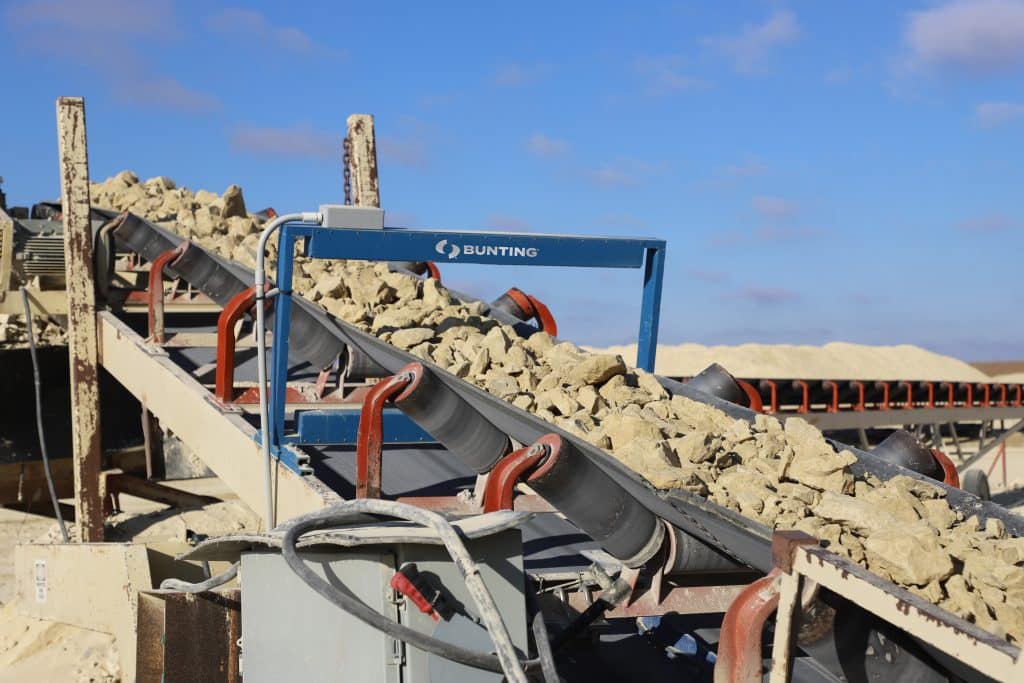
Case Study
Plasmor installed three Bunting metal detectors to locate tramp metal and prevent damage to processing plant at their building block manufacturing site in Heck, East Yorkshire, UK. The aggregate mix includes clay, Fuller’s earth (a by-product from other industries), and recycled dust from the plant’s extraction systems ensuring that the operation produces zero waste. Plasmor installed the three Bunting metal detectors on three separate material handling conveyors.
Bespoke Engineered Solutions
The removal of tramp metal is often critical. Damage to crushers, screens and conveyors disrupts and even stops production, at a huge repair and downtime cost. Failure to meet end-customer specifications for tramp metal content, especially in coal-fired power stations, results in costly financial damages or even the rejection of shiploads of material.
Large volume mining projects often require bespoke designed equipment. Bunting’s applications engineering team works closely with contractors and designers to understand the scope of the project. Once the challenges are identified, e.g., deep burden depth, wide conveyors, Bunting’s engineers design the optimum magnetic separator and metal detector solution, which is commonly bespoke to a project.
This understanding and knowledge is the result of designing and manufacturing magnetic separator and metal detectors for large mining projects for over 40 years.